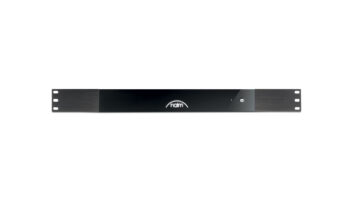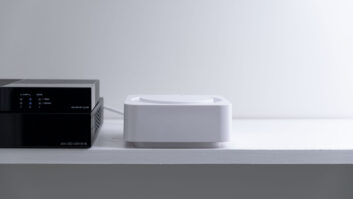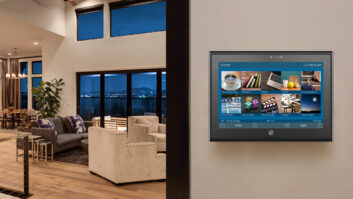This Integration Guide to Control Interfaces was sponsored by Crestron, Leviton, and RTI, as a supplement to ResidentialSystems, July 2014.

While Control4 has seen an increase in the number of apps providing control in the home, including the Control4 App for iOS and Android, they see a clear distinction between a mobile device and a dedicated control interface such as a touchscreen or remote control. The past few years, with the proliferation of IP networking and the ever-growing dominance of mobile devices, home automation and by extension the role and functionality of remote controls and touchscreens has shifted, though the desire for dedicated control, no matter how it is delivered has not.
What has changed is how manufacturers who cater to the custom integration channel have developed their remote control devices and systems, which now takes into account a strong consumer demand that their electronic devices uniformly perform actions in a gestural language born out of the rise of mobile devices, specifically smart phones with their swipes, swoops, slides, and taps. With the focus still on providing a comprehensive and unified approach to controlling home and automated systems, custom channel manufacturers across the board have naturally integrated these newer consumer expectations into both the design and functionality of their remote control devices.
“The global adoption of more reliable home wireless networks combined with the proliferation of products that can be controlled via IP, and the massive popularity of mobile apps has allowed us to develop network controllers and Wi-Fi interfaces and apps that have forever changed home control,” noted Cat Toomey, director of marketing for URC.

Clare Controls, too, remains committed to mobile devices as the outward-facing look and feel of the industry when they become ubiquitous lifestyle accessories. Toomey noted that the “control intelligence” now lives in the system controller, and that interfaces, such as URC’s remotes and touchscreens, no longer need to be “smart.”
“They can now transfer trigger commands to the controller and sit by while macros and other control sequences are generated by the controller and relayed to various devices,” Toomey explained. “This positively impacts system speed and capability, and also allows for instant, more informative user feedback on our newest Wi-Fi remotes.”
Still Dedicated
One of the truths that has long been evident for remote control manufacturers is that while having remote control functionality via a mobile device (and app) has that wow factor and plays into consumer yearning for Swiss Army knife living, the long-term consequences of lost or absent phones means the demand for dedicated remote controls and touchscreens has not lessened.
“While we have certainly seen an increase in the number of apps providing control in the home, including the Control4 App for iOS and Android, there is a clear distinction between a mobile device and a dedicated control interface such as a touchscreen or remote control,” said Paul Williams, Control4’s vice president of security and communication products. “As such, this device typically has a single owner or limited group of owners. This device also by definition is a mobile device and typically moves within the space and in and out of the space, so relying on that device as the primary interface for a home automation system has proven to not be a great customer experience.”
Such field reports are not unusual and continue to underscore why custom-grade remote control devices interfaces—such as URC’s Total Control and new ccGEN2 systems, which are built on the IP platform, and Control4’s latest touchpanels with video intercom capability and beam forming microphones with wide band audio—continue to be strong options for consumers.

Customer feedback has laid the groundwork for ELAN’s new controllers, including an HDMI-based on-screen display and a simple remote. “Technological developments like capacitive touch have helped develop sensory awareness in our clients,” said Crestron’s residential marketing manager, Delia Hansen, who also noted that the company’s entire line is going to offer operational features like capacitive touch, HD resolutions, stunning color depth, internet connectivity, and voice recognition.
“They expect a certain feel, reactivity, and performance associated with modern mobile devices,” Hansen added. “We have streamlined our offerings to provide a wide array of capacitive touch controls that are modern and help clients stay connected with their homes.”
Defined Interfaces
With this mirroring of mobile device functionality further enhanced by the robust backbone and background functionality that only dedicated remote control devices can offer comes the need for equally as defined user interfaces, among them touchscreens, which underscores Honeywell Security’s Ralph Maniscalco’s point that a rich user experience is the most important guiding principle in developing products for the company, including its new LYNX7000, a self-contained wireless touchscreen security and home automation system that features enhanced video capabilities and usability.

Honeywell Security believes that a rich user experience is the most important guiding principle in developing products for the company, including its new LYNX7000, a self-contained wireless touchscreen security and home automation system that features enhanced video capabilities and usability. “A clean, easy-to-use interface is another guiding principle, as well as the ability to control the system remotely from a mobile device,” Maniscalco, Honeywell’s director of marketing, explained, after noting that a study of its customer base revealed that alarm and video features are in demand. “A final key driver is the ability to provide a true end-to-end solution, aligning everything from product and software design to communications paths and application development to provide the best user experience for our customers.”
A uniform user experience is also behind Leviton Security & Automation’s OmniTouch 7 touchscreen and its OmniTouch Mobile app, which replicates its progenitor.
“The uniformity of the design benefits end users because they only have to learn a single interface,” said Greg Rhoades, Leviton’s director of marketing. “Whether they are in their foyer or on the beach in Fiji, they’ll always know where to go to unlock a door, dim a light, or adjust the temperature. This makes it great for young children and elderly alike, whether in English, Spanish, French, or Italian. The quick-glance LED even shows if the alarm is armed or not without having to wake up the screen.”
Savant Systems’ Universal Remote similarly aims for streamlined functionality—a feature that Jim Carroll, the company’s executive vice president of corporate strategy and business development, said was borne out of customer feedback for low-cost, no-configuration user interface devices.
“Wi-Fi and automatic device configuration is a simple setup for the Savant Universal Remote,” Carroll said. “Integrators can add features to a Savant system remotely and the remote control automatically grabs those updates over Wi-Fi. Build one robust Wi-Fi network for the customers full needs, and you’ll have happier customers and more robust installs.”

Savant Systems aims for streamlined functionality from its control interface design. Customer feedback also laid the groundwork for ELAN’s new controllers, including an HDMI-based on-screen display and a simple remote. With the goal of creating a benchmark for point-of- entry solutions and improved overall product functionality, Joe Lautner, Core Brands’ director for control products, said that they design their touchpanels and remote controls to provide a wide range of possibilities for their end-users.
“For example, lower cost keypads used for quick audio and lighting control may provide a faster response time than launching an app,” Lautner noted. “For some functions, like scheduling, study history, setting favorites, and lighting scene adjustment, a graphical interface,” or app, may be best. ELAN is dedicated to providing a wide range of user interface options to give customers the best choice for them.”
Applying Apps
It can be argued that the continued viability of dedicated remote control systems and devices is the life force behind apps, which in their consumer-friendly form become another kind of advertising for their more aggressive parents.

As a cloud-based solution, On Controls is inherently able to effectively play in a mobile ecosystem, harness by, like so many of its competitors mentioned here, customer feedback. “One of the biggest driving factors behind our products is the excitement consumers have when it comes to control via smartphones and tablets,” said Pete Baker, RTI’s vice president of sales and marketing, who also noted that the company is working to make its existing handheld and in-wall controllers even more enticing for consumers. “We think it’s great to offer system access through these devices, and have responded to the demand with our award-winning RTiPanel app. However, there are also limitations in relying solely on a mobile device for control, whether it’s the lack of tactile control, batteries dying, Wi-Fi issues, or the device simply being used elsewhere or for another activity. All of these issues underscore the importance of having a dedicated controller in every system.”
Vantage Controls’ Equinox line of mobile apps, which target luxury automation systems owners looking for a simple interface, deliver an automation system used to manage home systems with the touch of a button, according to Reid Cram, director marketing communications. “Control lighting, video, audio, surveillance, alarm, HVAC and more at home or on the go with a consistent user experience across in-home and mobile platforms. The widget-based system allows users to test-drive new features and make updates as their needs change, making Vantage the home automation system that grows with you.”

A uniform user experience is also behind Leviton Security & Automation’s OmniTouch 7 touchscreen and its OmniTouch Mobile app, which replicates its progenitor. Clare Controls, too, remains committed to mobile devices as the “outward-facing look and feel of our industry when they become ubiquitous lifestyle accessories,” as noted by CEO Brett Price, who went on to point to Apple and Google as the foundation for its own line of remote control apps.
“By intelligently applying the standards pioneered by Apple and Google for their mobile devices, we give our user interface a foundation of familiarity, comfort, and competence that translates very directly into customer satisfaction,” Price explained. “We then go a step farther, giving our users the option of personalizing their interfaces in exactly the same way they have made their phones and tablets uniquely personal devices, despite the fact that they share common hardware. So, when a Clare user picks up his or her iPad, for instance, the controls are based on what they love to do, and not automatically on the room they’re in.”
As a cloud-based solution, On Controls is inherently able to effectively play in a mobile ecosystem, harness by, like so many of its competitors mentioned here, customer feedback.

“The On Controls product road-map has so many possibilities,” said Itai Ben-Gal, CEO. “As an example, we have delivered full Nest compatibility, which enables users to enjoy colorful ambient lighting control from within the On Controls app. This functionality is available via Apple or Android phone or tablet and can be operated either locally or remotely. Integrators are adding Nest functionality to control and automation packages of all sizes and price ranges.”
Staying in Control

RTI’s SURFiR remote keeps actions on mobile apps in sync with the handheld remote. Remote control of consumer electronics and devices is one of those things that can be easily taken for granted; especially as everything from televisions to ceiling fans are now boxed with basic point-and-click remotes. However, it remains the domain of custom integrators and their supporting manufacturers to take clients beyond these simplified clickers, providing a comprehensive and unified approach to controlling home entertainment and automated systems that rely on dedicated remote controls and touch-capable screens and interfaces.
Llanor Alleyne is a contributing editor to Residential Systems.

Vantage Controls’ Equinox line of mobile apps, which target luxury automation systems owners looking for a simple interface, deliver an automation system used to manage home systems with the touch of a button.







